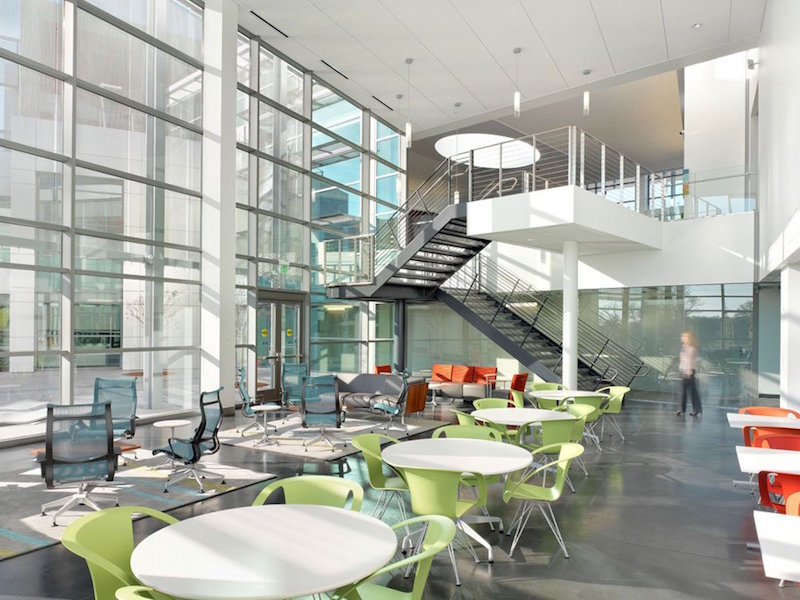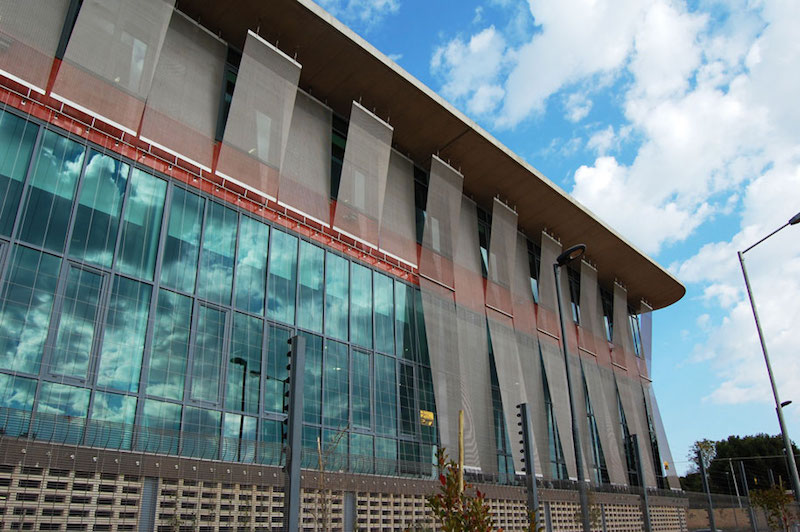CAMBRIDGE, MD (April 6)-- There are two distinct benefits produced as a byproduct of designing daylighting into office building design. Numerous studies have been done to support the positive effects of direct sunlight access in the work environment. One study done recently determined that access to daylight throughout the day improves employee wellbeing and overall health, even after leaving the office. Aside from the health factors, there are serious environmental benefits, by creating more energy efficient buildings reducing the need for artificial lighting.
Modern glass building facades are not the ultimate solution - on their own. Glass buildings result in interior overheating from direct sunlight, but there is a simple design solution available that can reduce solar overexposure throughout the day. Adding a material specifically designed for solar shading, like GKD’s solar line of metal mesh, offers a way for workers to have an unobstructed view of the outside while reducing glare and temperature. The outer shell supports energy-efficient climate control by allowing solar heat into the building in winter and screening the building from solar radiation during summer.
Solar protection systems reflect thermal radiation before it reaches the actual building shell. To efficiently screen insulating glass surfaces, systems of this type have to be installed outside the glazing. Yet this is precisely where materials are exposed to all manner of environmental conditions, such as wind, rain, snow or frost. Choosing the right material is thus vital in securing the longevity of solar protection systems. GKD metal fabric is manufactured from stainless steel and so ideally suited to applications of this kind.
So that the available solar heat energy can be used efficiently, the solar protection should be deactivated during the heating period. However, some form of screening may still be necessary to prevent glare. For this reason modern buildings often employ a combination of externally-mounted solar protection and internal glare screening. Thanks to their open structure, metal fabrics from GKD offer good screening when the sun is high in the sky and good solar heat gains when it is low.
Direct sunlight can cause glare, particularly for staff working on monitors. Inconsequence this can negatively affect work performance as well as overall well-being. A combination of solar protection and independent glare protection makes good sense. GKD metal fabrics are ideal for providing effective solar protection and can be combined with a large number of glare protection systems.
Controlling daylight and maintaining a clear outward view are important factors that can help staff feel comfortable at the workplace. In many countries these basic conditions are legally required for workplaces even when active solar protection systems are in place. In addition, daylight can help reduce power consumption in offices in two different ways. Firstly, it minimizes the need for artificial lighting. Secondly, since less artificial lighting is used, less waste heat is generated. The open structure of GKD metal fabrics allows daylight to enter the building without restricting any outward views.
 Photo Credit: GKD-USA
Photo Credit: GKD-USA
Equally important are the benefits produced to employee health. In an article published in the Journal of the Clinical Sleep Medicine the impact of daylighting was explored more heavily than previous studies. While previous studies thoroughly examine the effects of light exposure on office workers, this study specifically examines the workers quality of life particularly related to their well-being and sleep quality. Since poor sleep quality in particular can have detrimental health effects.
Interestingly, this trend towards healthy building environments began in the 1970s with the “sick building syndrome” and the World Health Organization’s Declaration on Occupational Health for All in the 1990s. Daylighting attributes, with the movement of green building, have become a focal point in architectural design but it is still not a necessity. Although several countries (Germany, Canada and France) have recommendations for daylighting in offices and schools, even there it is not a requirement. Domestically, our building codes focus on safety and fire ratings, with a smaller emphasis on daylighting. One reason for this study, and similar studies, is to scientifically prove the benefits of daylighting in the work environment and beyond.
In fact, the study, which was completed by students and doctors at independent, international Departments of Architects and Neurology, concluded that, “We suggest that architectural design of office environments should place more emphasis on sufficient daylighting exposure of the workers in order to promote office workers’ health and well-being.” This study can of course be translated into the school and healthcare environments as well.
The positive effects of daylighting are twofold: employee wellbeing, and energy efficiency. Couple these major benefits with the use of transparent metal mesh, sustainable and healthy building design can improve the environmental footprint of a building without compromising aesthetics.
About GKD
As the leading full service provider of woven metal fabric for architectural solutions, GKD-USA draws on more than 85 years of German engineering excellence, precision American manufacturing and expertise as the originator of the category. With eight manufacturing facilities and more than 600 employees worldwide, GKD metal fabrics have been specified by renowned architects and designers for thousands of interior and exterior applications. Serving as technical design consultants on each project, our collaboration with architects, facility managers and building owners begins at the conceptual design phase and continues through specification, installation and testing. Our experience at all levels of the design-build process underscores the fact that each project comes with its own set of considerations and details. Our mission is to address each to achieve safe, beautiful and long-lasting installations. GKD metal fabrics are produced in a wide variety of weight, texture, degree of transparency and flexibility for unlimited design versatility. Dynamic and static graphics may be integrated through proprietary LED technology and surface etching techniques. GKD Worldwide Weave encompasses three business units: CreativeWEAVE architectural meshes (GKD Metal Fabrics), SOLIDWEAVE industrial meshes and WEAVE IN MOTION for process and transport belts. For more information, follow us on Twitter and Facebook or visit http://www.gkdmetalfabrics.com
Media Contact:
Emily Wilson
The Ludlow Group
(757) 486-7300
nick@theludlowgroup.com






